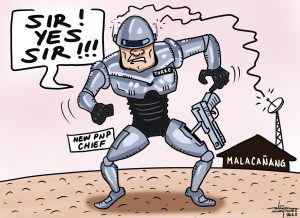WE appreciate the ingenuity of the people on top of the P12-billion bulk water supply project that is expected to enhance the water distribution capacity of the Davao City Water District (DCWD). We refer to the jointly-operated Apo Agua Infrastructura, Inc. by a Cebu-based conglomerate and huge construction company J.V. Angeles, Inc. based in Manila.
It is apparent, the firm executives’ efforts to ensure the completion of the project on time, made them skip the normal scheme of acquiring right of way for the project implementation. Instead of individually negotiating with various land owners whose properties will be affected by the laying of huge pipes they worked it out with the national and local governments for the construction company to lay the pipes in the ground below the concreted barangay and/or national road system.
Thus, it is clear that the company is saved the trouble of bigger allocation for right of way acquisition. From what we learned the bulk water firm will only have to restore the destroyed lane of the roads affected to its former cemented status when all the pipes shall have been laid and the soil becomes stable.
The likelihood therefore, is that the joint venture firm may have only negotiated with Davao City’s local government officials for barangay roads, and the Department of Public Works and Highways (DPWH) in cases of national roads being passed through.
One of the most affected is the road from Talandang in Tugbok district to Calinan proper. The entire five or more kilometer stretch has a width of five meters, with some portions having a width of 6 meters. In other words, the average width of the lane where the bulk water firm is digging a roughly 1.5 meter wide x 8 feet deep canal for the pipe to be laid is the entire half of the 2-lane road. This therefore, renders only the other lane passable for vehicular traffic.
Not much of a problem really if the stretch the contractor is digging is divided into shorter distances.
But no, it is not. Some stretches for example, specifically the ones from Biao Joaquin and Talomo Riverside, average a kilometer each. So one can only imagine the long line of vehicles from both approaches when company heavy equipment are occupying portions of the opened lane.
Last Saturday morning we observed the worst situation. Not only that there were heavy vehicles of the contractor unloading some machinery or loading the excavated soil, the men assigned to man the ingress and egress from both approaches appeared to be very wanting in coordination. When the lack of discipline of some drivers was added to the fray, the result was an hour of standstill and dangerous maneuvers to let the vehicles coming from opposite directions pass through.
We were one of those stuck in the gridlock for about an hour. We have observed that there were not a single personnel of the construction company that helped in untangling the traffic mess. Instead we saw them talking on the canal side doing what seems to be nothing.
Yes, those assigned to control the vehicles at the entry and exit points in each of the stretches where the digging is still ongoing or the pipe-laying still in the works, have hand-held radio communications equipment. And we assume that they are giving each other signals when to allow vehicles to move into the single lane stretch.
But based on our observation it appeared then that the controllers were not communicating effectively. The one manning the ingress at our end signaled for our vehicles to proceed. But to our chagrin, we realized that when our line was barely a 150 meters away from our exit point, huge trucks were also moving towards our direction followed by several others. That was when bedlam started. At our end it was extremely difficult to maneuver because at the right side of the vehicles on out line is the deep canal dug by the contractor. Or, if the canal portion is already covered, the soil is still very soft due to the incessant rains during the past few days. The danger that vehicles on our side will get its tire buried in mud was very real. And such incidents will only add to the standstill of the traffic.
Yes, we are aware of the visible inconvenience the pipe-laying work is giving to the travelling public in that part of the city. And we know that the commuters are willing to live with such inconvenience for the duration of the project implementation. After all, they stand to benefit from the final outcome of the improved water services, not just to those residing in the areas affected but also to those in the northern part of Davao City where water service is far from ideal since the DCWD came into being.
But the one we feel revolting to the senses of the commuters taking that mentioned route is the apparent failure of the contractor to set up an effective coordination of their men manning vehicle movements entering its many work sites. We also believe that the vehicle entry controllers should be around between 5 a.m. to 7 p.m. when curfew hours set in. There has to be relievers for those who will take their meal breaks, especially during lunch time. Why, because there is no meal break in the passage of vehicles on the road concerned.
We are hoping that this is not too much of a request from the inconvenienced public considering that the scheme adopted by the implementing company is out of the normal conduct of undertaking government projects.
Should the JV Angeles management consider looking into this issue and do the necessary to address the problem, we are certain that the firm can be remembered as a caring and responsible corporate citizen.
After all, that is what its partner is known for.


